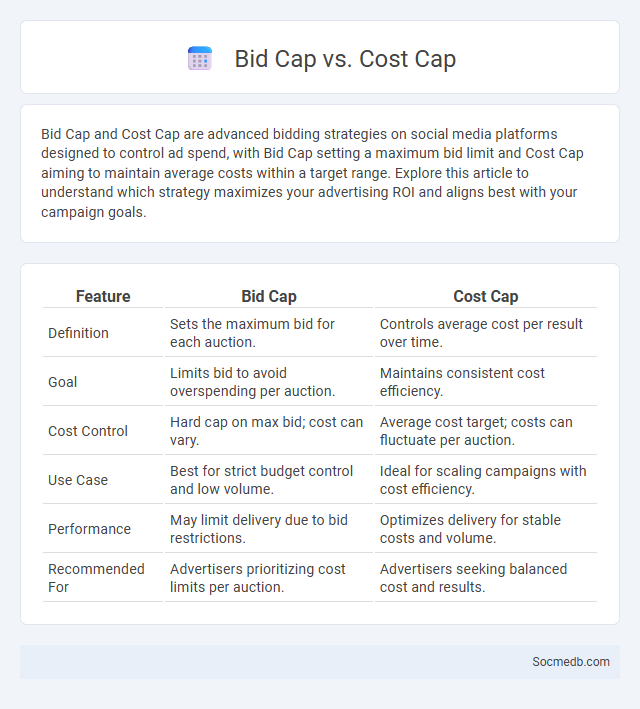
Photo illustration: Bid Cap vs Cost Cap
Bid Cap and Cost Cap are advanced bidding strategies on social media platforms designed to control ad spend, with Bid Cap setting a maximum bid limit and Cost Cap aiming to maintain average costs within a target range. Explore this article to understand which strategy maximizes your advertising ROI and aligns best with your campaign goals.
Table of Comparison
| Feature | Bid Cap | Cost Cap |
|---|---|---|
| Definition | Sets the maximum bid for each auction. | Controls average cost per result over time. |
| Goal | Limits bid to avoid overspending per auction. | Maintains consistent cost efficiency. |
| Cost Control | Hard cap on max bid; cost can vary. | Average cost target; costs can fluctuate per auction. |
| Use Case | Best for strict budget control and low volume. | Ideal for scaling campaigns with cost efficiency. |
| Performance | May limit delivery due to bid restrictions. | Optimizes delivery for stable costs and volume. |
| Recommended For | Advertisers prioritizing cost limits per auction. | Advertisers seeking balanced cost and results. |
Introduction to Ad Auction Strategies
Ad auction strategies on social media platforms like Facebook, Instagram, and Twitter determine how ads are displayed to users based on bids, relevance, and user engagement metrics. These auction systems optimize ad delivery by evaluating advertiser bids alongside predicted click-through rates and ad quality scores to maximize value for both users and advertisers. Understanding the dynamics of bid strategies, budgeting, and audience targeting is crucial for improving campaign performance in competitive social media advertising environments.
Understanding Bid Cap in Advertising
Bid Cap in social media advertising sets a maximum limit on the cost per bid during an auction, enabling advertisers to control their spending while aiming for efficient ad delivery. This strategy helps optimize campaign performance by preventing unexpected cost spikes and maintaining a predictable return on investment (ROI). Understanding Bid Cap is crucial for maximizing budget efficiency and achieving targeted audience reach in platforms like Facebook and Google Ads.
What is Cost Cap and How Does It Work?
Cost Cap is a bidding strategy used in social media advertising to control your average cost per result while maximizing the number of conversions. It works by setting a maximum allowable cost, enabling the platform's algorithm to optimize ad delivery within your specified budget constraints. This ensures that your campaigns achieve optimal performance without exceeding your desired cost threshold.
Ad Auction Mechanisms Explained
Social media platforms use ad auction mechanisms to efficiently allocate advertising space by evaluating bids, user relevance, and ad quality. These auctions consider factors such as bid amount, ad relevance score, and expected user engagement to determine which ads are displayed. This system maximizes revenue for platforms while ensuring advertisers reach their target audiences effectively.
Key Differences: Bid Cap vs Cost Cap
Bid Cap controls the maximum bid amount in auctions, ensuring your spend per impression does not exceed a set limit, which is crucial for strict budget management. Cost Cap optimizes for cost efficiency by maintaining your average cost per result near a target while allowing for flexible bidding to maximize delivery and results. Understanding these differences helps you tailor your social media campaigns to You achieve precise control or balanced cost-effectiveness based on Your advertising goals.
Advantages of Using Bid Cap
Using Bid Cap in social media advertising ensures precise control over maximum bid amounts, preventing overspending on ad placements while maximizing return on investment (ROI). This strategy helps advertisers maintain budget efficiency by setting clear bid limits in platforms like Facebook Ads Manager and Google Ads, optimizing cost-per-click (CPC) and cost-per-acquisition (CPA). Implementing Bid Cap allows targeted audience reach without sacrificing ad delivery, improving campaign performance and promoting sustainable ad spend in competitive bidding environments.
Benefits of Utilizing Cost Cap
Utilizing Cost Cap on social media platforms maximizes budget efficiency by controlling average costs per desired action, ensuring campaigns deliver consistent and predictable results. This strategy enhances return on ad spend (ROAS) by optimizing ad delivery toward high-value conversions without overspending. Advertisers benefit from improved cost management and scalable growth, making Cost Cap a powerful tool for performance-driven marketing.
When to Use Each Strategy in Your Campaign
Choosing the right social media strategy depends on campaign goals, target audience behavior, and platform strengths. Utilize brand awareness strategies on visual platforms like Instagram and TikTok for creative engagement, while LinkedIn is optimal for B2B lead generation and professional networking. Performance-driven campaigns benefit from Facebook and Google Ads due to their advanced targeting and analytics capabilities.
Impact on ROI and Campaign Performance
Social media platforms significantly enhance ROI by enabling precise targeting and real-time engagement, which increase conversion rates and lower customer acquisition costs. Campaign performance improves through data-driven insights, allowing marketers to optimize ad spend, refine messaging, and measure key performance indicators (KPIs) such as click-through rates, engagement metrics, and return on ad spend (ROAS). Leveraging social media analytics and A/B testing maximizes campaign effectiveness and drives sustained revenue growth.
Choosing the Right Bidding Strategy for Your Goals
Selecting the right bidding strategy on social media platforms is crucial for maximizing ROI and achieving specific campaign goals such as brand awareness, lead generation, or conversions. Platforms like Facebook and Instagram offer options including cost-per-click (CPC), cost-per-thousand-impressions (CPM), and cost-per-action (CPA) bidding, each tailored to different marketing objectives. Analyzing campaign metrics and adjusting bids accordingly ensures effective budget allocation and optimized ad performance.
 socmedb.com
socmedb.com